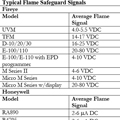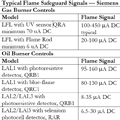Avoid potential boiler explosions with this safety device.

|
|
A flame safeguard is much more expensive than a simple thermocouple, but will respond within four seconds. Photo credit: Ray Wohlfart |
As I accompanied my friend from the local utility company into the boiler room, I noticed the covers were off all the electrical boxes and wires were hanging out of them. That is never a good sign. The purpose of my visit was to offer some suggestions to help the client lower its fuel costs, as the client was having a difficult time paying its gas bill. Our meeting included the director of maintenance and his boiler maintenance staff.
As we were talking with the maintenance personnel in the boiler room, the lead boiler tech said he needed to start the boiler. I watched as he walked to one of the large boilers and opened the door to the base of the boiler. He took a broom, lit the bristles on fire and shoved the lit broom inside.
His next task froze me. He opened a 2 1/2-in. manual gas valve and the burner started with a soft “Whoom.” Flames were visible from the opening of the boiler. He pulled the broom out and stomped on it to extinguish it.
I gasped loudly and the maintenance man laughed. “Why do you do that?” I asked.
“Aw, the flame safeguard is defective. Do you know how much those things are?” he answered.
“So you bypassed it?” I stammered.
“Yep, been like that for months now. Whenever we need heat, we just light the broom and off we go. You gotta be careful sometimes. That flame will singe your hair,” he said.
I do not know whether I was more concerned with how they “lit” their boiler or that they thought it was OK to do.
The maintenance man is correct. A flame safeguard is much more expensive than a simple thermocouple. Some maintenance people will ask why the industry has gone away from thermocouples. The main reason is response time. The response time for a thermocouple is between one and three minutes. A flame safeguard will respond within four seconds.
It may not seem like a big deal but consider this. If the flame goes out on a 1 million-Btuh boiler with a thermocouple and the thermocouple response time is two minutes, the boiler will have about 16 cubic ft. of gas. Mixed with the combustion air, it would equal about 240 cubic ft. of an explosive mixture.
Contrast that with a boiler with a modern flame safeguard with a four-second response time. It would allow slightly more than 1 cubic ft. of gas and the explosive mixture of air and gas would be about 16 cubic ft. - about 94% less.

|
|
Table 1 |
How it works
During my seminars, I am often asked how a flame safeguard operates. A flame safeguard is a sophisticated control that monitors fuel-burning equipment to assure safe operation. On a call for heat, the flame safeguard will start the burner fan. The blower operation is verified with a sensing device, usually a pressure switch.
If the burner is a modulating one, the burner air intake damper will open. This is called a “pre-purge.” The fan will operate for anywhere from 30 seconds to several minutes. This is to “purge” the boiler combustion chamber of any unburnt fuel. The purge will be enough to provide four full air changes in the combustion chamber.
After the pre-purge, the pilot will light. The flame safeguard will check the pilot flame to make sure that it is safe and stable. If the burner is a modulating one, it will drive to a low fire position.
At that point, the main gas valve will open. The flame safeguard will continually monitor the flame until the call for heat has ended. Some older burners used a “post-purge” to void the combustion chamber of any unburnt fuel after the call for heat. This is wasteful as it will take heat from the boiler and exhaust it up the stack.
Another consideration with flame safeguards are the flame-sensing types. The four common flame-sensing devices are: flame rectification (more commonly known as a flame rod); photo cell; ultraviolet; and infrared.

|
|
Table 2 |
Flame rectification is the most common sensing device. It uses a theory that a flame will actually conduct electricity. I wonder how many singed eyebrows there were when they tried to test that theory! A small electrical charge will be sent to the flame rod. If a flame is present, the current will travel through the flame to the ground. If the ground is sensed, the main gas valve will open.
The photo cell, common for fuel-oil burners, looks for the visible light of a flame. When light is present, the sensor will emit electrons and tell the flame safeguard that a flame is present.
Infrared flame sensors can be used on either gas or fuel-oil burners. It senses the infrared radiation that is present in a flame. However, it can sometimes be fooled by hot refractory inside a boiler.
Ultraviolet flame sensing tests for the ultraviolet waves that are present inside a flame. The UV sensor will not respond to any visible light. It can be fooled by hot refractory, spark ignition, gas laser, sun lamps, germicidal lights and a bright flashlight.
The best way to check the operation of a flame safeguard is with a meter. Tables 1 and 2 will show you the suggested readings for different flame safeguards.



